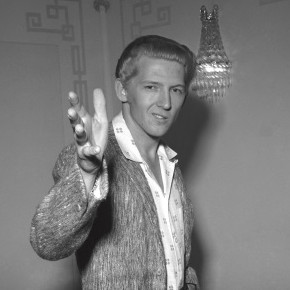“Great Balls of Fire” is more than just a song; it’s an explosive moment in rock and roll history. Performed with unparalleled energy and raw talent by Jerry Lee Lewis, this track ignited dance floors and solidified his place as a true icon. Released in 1957, “Great Balls of Fire” became an instant classic, capturing the rebellious spirit of early rock and roll and showcasing Lewis’s signature “Killer” persona. This article delves into the story behind this iconic song, exploring its creation, impact, and enduring legacy in the world of music.
 A jukebox, with the words
A jukebox, with the words
The Genesis of a Hit: From Otis Blackwell to Sam Phillips
The story of “Great Balls Of Fire Song” begins with Otis Blackwell, a prolific songwriter known for penning hits for artists like Elvis Presley and Little Willie John. Blackwell crafted the demo for “Great Balls of Fire,” recognizing its potential to be a high-energy rock and roll anthem. When the demo landed in the hands of Sam Phillips at Sun Records, both Phillips and Jerry Lee Lewis immediately knew they had something special. Phillips, renowned for his ear for raw talent and groundbreaking sound, was particularly impressed with Blackwell’s demo and challenged himself and Lewis to elevate it even further in the studio.
Crafting the Killer Sound at Sun Records
Jerry Lee Lewis was already making waves with his previous hit, “Whole Lotta Shakin’,” but “Great Balls of Fire” was designed to amplify his explosive stage presence and piano-pounding style. In the studio, Phillips and Lewis meticulously worked on perfecting the track, paying close attention to the dynamic stop-start intro that became instantly recognizable. This intro, reminiscent of Carl Perkins’ “Blue Suede Shoes,” set the tone for the song’s fiery energy.
Interestingly, the musicians who backed Lewis on “Great Balls of Fire” were not his usual band members or the regular Sun Records session players. Sidney Stokes on bass and Larry Linn on drums joined Lewis for this recording, creating a unique sonic blend that perfectly complemented his wild piano playing. Lewis himself recalled never encountering these musicians again after the session, adding to the almost mythical creation of this iconic track.
 Jerry Lee Lewis
Jerry Lee Lewis
During the recording process, a moment of internal conflict arose for Lewis. The title “Great Balls of Fire” sparked a theological debate within him, as he wrestled with the perception of rock and roll as “the Devil’s music.” A recorded discussion between Lewis and Sam Phillips reveals Lewis’s genuine concern about the song’s potentially “Satanic” undertones and his own destiny. Phillips, with remarkable patience, managed to reassure Lewis and guide him back to focusing on the music, ultimately ensuring the completion of the recording.
An Instant Sensation and Cultural Phenomenon
Released with Hank Williams’ “You Win Again” as its B-side, “Great Balls of Fire song” became an immediate sensation. It sold over a million copies within its first ten days of release, catapulting Jerry Lee Lewis to superstardom. The song’s raw energy, combined with Lewis’s charismatic performance, resonated deeply with audiences.
The song was also featured in the film Jamboree, further amplifying its reach and solidifying its place in popular culture. While the film itself was a typical rock and roll exploitation film of the era, Lewis’s performance of “Great Balls of Fire” was a standout moment. This cinematic exposure helped to cement the song’s iconic status and introduce Jerry Lee Lewis to an even wider audience.
“Great Balls of Fire” became a defining anthem of 1950s rock and roll, capturing the genre’s rebellious spirit and unbridled energy. It established Jerry Lee Lewis not just as a star, but as a force of nature in the music world. Recordings from this period and beyond, showcasing Lewis’s versatility from Hank Williams covers to blues numbers like “Big Legged Woman”, demonstrated the breadth of his talent, but “Great Balls of Fire” remained his signature explosive track.
The Shadow of Controversy and Enduring Legacy
Following the massive success of “Great Balls of Fire” and its follow-up, “Breathless,” Jerry Lee Lewis’s career faced a dramatic turning point. His arrival in the UK for a tour in 1958 was met with scandal when the press discovered his marriage to his thirteen-year-old cousin, Myra Gale Brown. This revelation triggered a public backlash that abruptly halted his momentum and significantly impacted his career in the short term.
Despite the controversy, the power of “Great Balls of Fire song” has never truly diminished. It remains a staple of rock and roll radio, a favorite in live performances, and a testament to the electrifying energy of early rock and roll. Covered by countless artists across genres, from Dolly Parton to Aerosmith, “Great Balls of Fire” continues to ignite new generations with its timeless appeal. The song’s legacy transcends the personal controversies surrounding Jerry Lee Lewis, standing as a monument to his musical genius and the enduring power of rock and roll. While his personal life was complex and often turbulent, his contribution to music, particularly through “Great Balls of Fire,” remains undeniable and continues to inspire awe and excitement decades later.
